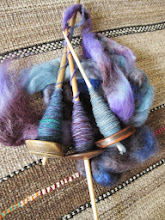Ancient Egyptian linen. I got to look at some, up close.
Having recently read Barber's description of linen splicing in Prehistoric Textiles, I knew that the places that looked plied were most likely spliced, and these spots were visible here and there in the woven cloth. There's one going across in the photo below, just below the center of the image. If it works to click on these photos and see them bigger, you may be able to find more splices in other images.
I found a blue striped border, which recurred in several fragments. As you can see, the weave is warp-dominant - probably because the weaving was done on ground looms (as per Barber.)
Similar designs were displayed in the British Museum:
I found some fringe, and a seam, both of which may be part of the "additional tunics" mentioned in the conservation article from 1979.
That's the view of the seam that was on the inside, as the fabric lay in storage. On the other side, there is some lint along the fold, which I found very interesting - what would the lint be made of? It looks fluffy, like wool. And how old would the lint be? Ancient Egyptian lint? Or storage lint?
And here's an absolutely perfect selvedge, top of the photo below. It's not folded or anything - it's that straight.
The bulk of the perfect-selvedge cloth looked like this, with some uneven spaces between warps.
I could not decide if this was a result of deterioration or distortion from long years crumpled in storage, or if it appeared this way when it was originally woven. (The dark spot up top is a hole.) Anyway, I let the unevenness encourage me, since my current backstrap weaving has a lot of variation in the space between warps.
There was a wide range of density-to-lightness in the fabrics, with the linen threads also thicker in some cloth and finer in others. Here are two quite different piece, the upper one much lighter and finer.
Did I wish I could open each of these out and see the full size and shape and speculate more about their purpose? Of course I did! However, I was asked to disrupt them as little as possible, and truly any amount of unfolding risked further disintegration, so this was not the time to sort them all thoroughly. I was hoping that someday someone will, though.
Here is a knot. Just because it's there.
And finally, the Gurob sleeves (listed with other things on this helpful website), which I looked at (in a case, with the aid of a museum-provided flashlight/torch) after having examined the other linens. I was happy to see that I could make out the spliced sections on this fabric, which is much more finely and densely woven, and well-preserved. Beautiful seams, too.
These child-sized sleeves were made separately, to be attached to a sleeveless tunic as needed. This was apparently the custom, since Egypt is usually hot and most clothes were made sleeveless. I'm thinking the sleeves are densely woven because they are a warm layer for the cold season.
My appreciation for ancient linen production grew immensely that day.
Questions and comments welcome - don't be shy.
















6 comments:
Wonderful post!
Thank you, Tracy, for sharing these images and your notes.
Just guesses - as I have no training in any of this - but the two different weavings are probably from 2 different weavers and 2 separate projects - a length for clothing for summer and a length for household goods? That selvage is beautiful - do you know if they used a backstrap type loom or one on a frame?
My guess for the lint is from whatever the original collector had put it in. While I believe wool was used in Egypt, as they did have sheep, maybe the wool was for lower classes of people and linen saved for the 'elite'. Thanks for sharing what must have been a wonderful time touching things so very ancient.
Hi Gail, thanks for your comments.
The Egyptians at this time were weaving on ground looms, meaning the end bars were staked into the ground and the warp was horizontal. Contemporary Bedouin still use this style of weaving. The heddles are raised on supports.
The weaver has to sit either to the side of the weaving or on top of the woven fabric - Egyptian depictions show two women working the loom, one on each side.
Tracy, thanks SO much for sharing this! I envy your new path so much! What do you mean by splicing--you said what looks plied is actually spliced? Do you mean splicing the old length of yarn with the new?
Mary ("Consider" from the backstrap list, where I've fallen silent)
Hi Mary, sorry to take so long to answer you.
As Barber explains in her Prehistoric Textiles book, Egyptians used long strands of linen fibers, which had to be joined end to end by splicing. However long the spliced overlap is, that part looks like a plied thread. Otherwise, they look like singles.
Your posts are enlightening, interesting and beautifully written, the photographs alone would keep me glued to the monitor for quite a while! Thank you.
Post a Comment